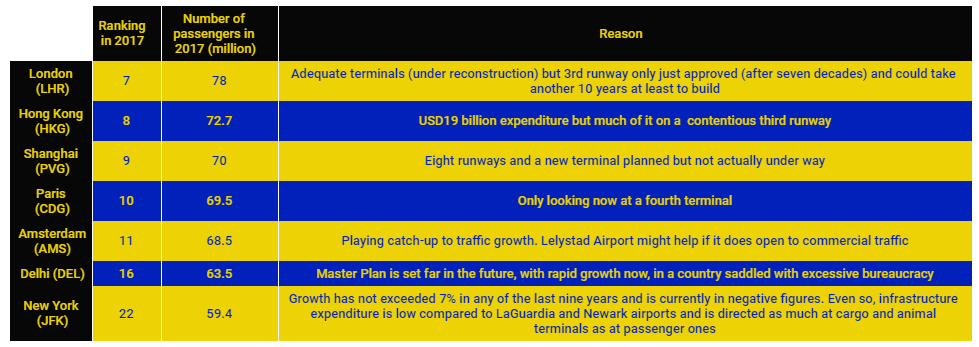Summary:
- An IATA executive says only four of the 'top 100' airports do not need major infrastructure upgrades in the next 10 years;
- The Blue Swan Daily analysis suggests there are perhaps twice as many as that just in the top 25;
- There are equally many airports that do need expenditure - in some cases pretty rapidly - together, in our opinion, with some borderline cases.
What Mr Mistry did not do though was to identify those airports. Firstly, we need to define what 'Top 100 airports' means. Typically it is a reference to size as measured by annual passenger throughput. But in another IATA statement at its AGM, 'top airport' clearly referred to quality ratings (such as ACI's ASQ Awards and Skytrax, which does have a Top 100 ranking with Singapore Changi at #1 in 2018). One must assume that an airport would not qualify as a 'top' one in IATA's judgement if it did not have adequate quality in its infrastructure, meaning that size matters in this case.
Research into his statement indicates that he may be over-playing the "infrastructure crisis" in the airport sector, based on growth patterns during the last three years that are unsustainable and which are always subject to sudden and dramatic, exogenous events. He is not the first to do that and will certainly not be the last.
Terminal construction is popular (affording many ways to earn additional revenues) but runways not so much (only one revenue stream). In that sense, Mr Mistry is correct about his conclusions So, looking at the 25 busiest airports only, for the sake of brevity, the Mistry Tour shortlist, so to speak, of airports not requiring "some form of major infrastructure upgrade" over the next 10 years, might look something like this:
 Source: CAPA - Centre for Aviation Airport Construction database
Source: CAPA - Centre for Aviation Airport Construction database
So even in this truncated example it is clear there are twice as many airports not requiring "some form of major infrastructure upgrade" over the next 10 years than are catered for in Mr Mistry's 'Top 100.' In some cases it is simply because new airports have been or are being built. But mainly it is because there is more infrastructure provision than is widely appreciated.
Some US airports in particular are more advanced with construction projects than they are credited with. For example, Los Angeles International where several modernisation projects, requiring investment of USD14 billion, are nearing completion. Meanwhile Chicago's O'Hare International has a USD15 billion programme in place to 2026 including USD8.5 billion announced this year, and covering a new runway and a 'global terminal'.
Possible 'outliers' to this table include Atlanta Hartsfield-Jackson International, because when current projects are completed it will have capacity for 121 million people when it has barely grown since 2009; by 17% over nine years, (though it is still the world's busiest airport).
Equally, there are airports in that 'Top 25' alone which do need to make concrete their infrastructure future rapidly:
 Source: CAPA - Centre for Aviation Airport Construction database
Source: CAPA - Centre for Aviation Airport Construction database
Finally, there are the 'In-betweeners', airports which potentially could qualify for Mr Mistry's list but where there are circumstances preventing that.
 Source: CAPA - Centre for Aviation Airport Construction database
Source: CAPA - Centre for Aviation Airport Construction database
The objective of this exercise was to put a little more meat on the IATA assertions, and to demonstrate that airport infrastructure projects are more in evidence than is widely believed, especially within the portals of IATA's offices.